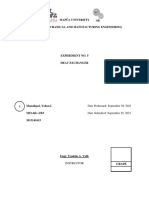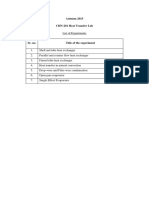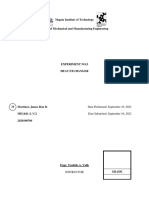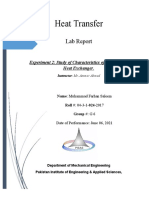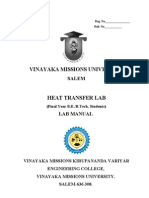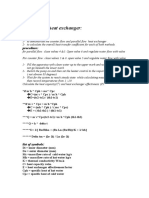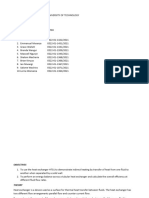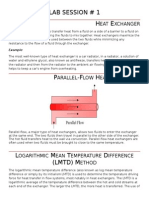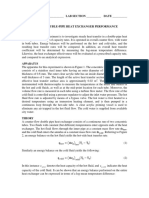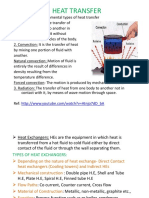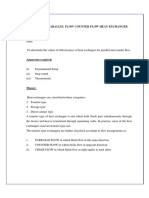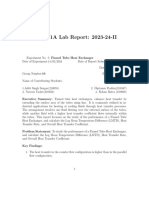0 ratings0% found this document useful (0 votes) 42 views15 pagesNotes
Copyright
© © All Rights Reserved
We take content rights seriously. If you suspect this is your content,
claim it here.
Available Formats
Download as PDF or read online on Scribd
“Heat and Mass Transfer Laboratory Manual:
OBJECTIVES
To determine the heat transfer coefficient in free convection for
THEORY
Convection heat transfer takes place between a solid surface
when the two are at different temperatures, When flow of |
means such as pump or fan, the convection is called forced
no any external means to cause the fluid flow, cor i
n, the fluid layer in contact
convection. In free conve
its density and the cold fluid ru
rises up due the decrease in
the void. Thus the motion of the fluid is induced by the
continuous and the heat transfer takes place due to the
experiment, heat transfer coefficient is calculated for 2
rred from the external surface of the pipe by free col
‘transfer
process, th
Regardless of the particular nature of the convection
convection is calculated from Newton's law of cooling:
Q=hAT, -T,)
Where Qis the heat transfer rate (W)
‘Ais the surface area perpendicular to heat tra
insfer direction (m?)
Tis the temperature of solid surface (K)
7,,is the temperature of ambient fluid (K)
his the heat transfer coefficient (Wim? K)
EXPERIMENTAL SETUP
aratus consists of 2 vertical brass pipe
otto open to faciitate the undisturbed natural convection ceneltions, For
tne pipe. an acrylic sheet Is fitted on the front side of the enclosure.
d inside the pipe to heat the wall of the
The app fitted in a large enclosul
(nichrome wire) is fits
m outer sul
dissipated 10"
thermocouples are embedded inthe wall ofthe pipe to MESSHIS the
(7, — Tr and another thermocouple is provided to measure the amt
‘ine input power of the heater is controled by a cimmerstat and
yometer and ammeter, The schematic diagram of the Setup is sho
Scanned with CamScanner�ction
Neat and Mass Transfer Laboratory Manual: Natural Conve
Wasene
Figure 1: Schematic of natural
‘SPECIFICATIONS OF THE SETUP
1 Outside diameter ofthe poe a
ae ceo
3. [Freosuasie
|__| Heater element (Nichrome wre)
“S| Types of thermocouple used,
[6 |Dimmerstat
PROCEDURE,
1) Put‘on’ the heater swich
2) Adjust the input power to the
(approximately 75)
23) Note down the heater input
4) Wait or around 10 minutes til
5) Note dawn the readings of
steady sates reaches
Repeat the experment
Make the dimmerstat
6
Scanned with CamScanner�ai convection
Ei
50
55 min.
60min
PRECAUTION r S ™
41) Keep the dimmersta at zero postion before switch
2) Operate the dimmerstat gently and increase the voltage gradually.
'3) Do not run the fans in the Laboratory while conducting this experiment
4) Operate the temperature indicator switch gently
5) Never apply the input voltage beyond 100 Volts to the heater
CALCULATIONS,
A Experimental
4) Heat tansfer area A= él (m?)
2) Heatinput=Vi aw)
3) Average surface temperature 7, — pe Tastee,
- LAT ATT: Ky
4) Average heat transfer coefficient Ae (Wim? K)
B. Theoretical
gineering, IIT Patna
Scanned with CamScanner�a
PRE
nual:
Heat and Mass Transfer Laboratory Ma
Peers arister |
aa tion a
ee ccelerat
iTV ynere gis the 2
Imabove Gr; is the Grashof number, Cr, 7
Weak, Jand 1
‘0 gravity, is the coefficient of thermal expansion (=
the kinematic. viscosity,
ite can ly
a vertical plat
The average heat transfer coefficient for natural convection from
Calculated from the following relation
387Ray'*
Nu =| 0.8254 _0.387 Ray
U + (0.492/ Py}
AL
IW above Nw is the Nusselt number Na
ay = Gr, Prand Pris the Prandtl number Pr a
RESULTS AND DISCUSSIONS
1) Calculate the heat transfer coefficient for two
2) Compare the experimental results of heat I
results.
3) Discuss the sources of errors and their eff
Department of M
Scanned with CamScanner�OBJECT
Using LMTD method.
2. To determine the heat ‘exchanger effectiveness for pal
THEORY
The double.
e heat exchangers are the simplest type of heat exchangers, where the heat exchange
betwieen the two fluids at diferent temperature takes place. The two pipes are concentric, one fuid
flows inside the inner tube while the other fluid inside thie annulus space between the two concentric
Pipes. A schematic diagram of the double-pipe heat exchanger is shown in Fig. 1. The water is
heated by means of instant water heater (geyser). The hot water is then made to pass through the
inner pipe of the heat exchanger while the normal tap water (cold water) flows through the annular
Tegion. The heat exchange between the two fluids takes place due to the temperature difference The
direction of the cold water is reversed by means of valves operation. The settings for the parallel and
counter flow arrangements have been mentioned in Fig. 1. The flow rate of the hot and cold water
streams are measured by the rotameters and the temperature of the two fluid streams at the inlet and
the outlet of heat exchanger are measured by means of thermometers.
ey ral pi Be
Hot we Water out
| | ‘Counter Flow Settings
| Wi Vales Vs & Va open
| a Vibe Wa Vs
ae Parallel Flow Settings
Wate
Heater Vales Vi 8 Vs pen .
(Geysen) r Valves Vs 8 Ve cose
tarneter
ota
C. _ ae
ve
rig. Schematic diagram of double-pipe Meat exchanger apparatus
‘9
ee
‘ngineering, 11T Patna
Department of Mechanical E
Scanned with CamScanner�eT
Lab Manual: Double Pipe Heat Exchang
fluid streams along the length of the heat excha
exchange, the temperature of hot water strean
Fig. 2 Temperature variation of hot and cold uid streams (a) parate! low (8) counts: flow Hx
t exchangers, namely, LMTD (fog mean femot
st
There are two ways of analyzing the heal
<£ (effectiveness) approzch.
difference) approach and another is NTU (number of transfer units)
Y
LMTD Approach
This method is applicable when the temperatures of the hot and cold flu streams st
btet OF tel heat BYERANEeIEIere Known, (t's proposed to calculate the heat transier rate
double pipe heat exchanger using the following relationship
Q-uaar,
where, the overall heat transfer coefficient, U, is given by
the inlet a
U= J —_
Alb inele |
hyA, 2rkL A,
‘and fe are the inner and outer radi of the inner tube of the double pipe heat exchanses
‘Ac is the outer surface area of the inner tube, and
Lis the length of the inner tube.
cesped
Department of Mechanical Engineering, IIT Patna
Scanned with CamScanner�Togarithmic function in the LMTD. In these
method based on the effectiveness ofthe heat
1 heat exchanger effectiveness is defined as
acs
energy gained by the cold fluid
Qamas = Hye, (Ty, ~T,
The max possible heat transfer can be determined if o
change equal to the maximum temperature difference
1
this maximum temperature difference will be the one wk
heat is minimum because as per the energy balance, he:
heat lost by another fluid;
nm 7.)
Assuming cold fluid as the minimum fluid and the p
represented by C (capacity rate). i
After simplification, the effectiveness can be expresses
For parallel flow arrangement :
expl(-UAL Can 1+ Ce 1G,
phe Tce (Cam
1 expl(-UA/ Cua) 1= Ca 1G]
1 (Cm [Cam )@NPU-VATC
For counter flow arrangement
6
A/C is called the numberof wafers STU) AS represen sizeof teh
The werm VAI Cin
exchanger.
Department of Mechanical Engineering, 117 patna
Scanned with CamScanner�‘Scanned with CamScanner�fu = AD, tk;
The hydraul
lic diameter Dy'is
sven by the folowing relation:
Dy =44,1P, i
Where A, perimeter
is the cros
a }€ cross-sectional area and P, is the well
F inside the tube prea
Toh
i (12a)
D,=4
ie! (12b)
pled? 4) (120)
For annulus region
hh,
(132)
ae (138)
ple(D?
Ei) re)
RESULTS AND DISCUSSIONS
Compare tre expetimental vue of'U wit ts heoretical vale 2nd calculate the
percentage error
— ete te posable reasons of devaionom me kMeOeH=| YAN
~ Gaompare the performance of pert nd courig Tai arrangements
‘Wich arrangement is better and hy?
wit aiscussion on ine result obined
CONCLUSIONS
n the results obtained
Draw conclusions 0°
PRECAUTIONS
sen on te neater afer he few of srateris set through the rotamer connecting R=
4. Aways switen O°
geyser
Handle thermore
valves vert
.e experiment
ce caretuly wie zara the ean
cea ach ot tho geyser it and then close atthe VaNSS
after finishing In
nical Engineering, 11T Patna
Scanned with CamScanner�-and-Tube Heat Exchanger _
— Heat & Mass Transfer Lab Manual: Shell
opsecr i
TTAReMnI® the overatheat vente cocci or set-andiute he
LTD method
OR etter grectanoss or eer one
Jers using
at exchangers
{ube heat exchanger
ber of tubes. The
The shelhand-ube heat exchanger consis 6f a cylindrical shell containing a num
Deepa Wp At GLEE A ova Gc iousanece scx ns uve nex ne are ae
Known quantity of hot water trom the Balser fe nat ofthe
(i eschenGer (foes) end thn cums tam ne peer unre through the heat exchanger length
(P8852) and finaly goes out ofthe hy
ffecve then the single pass heat
the length gets doubled. The cots
umber of bate plates and fina emai ranser occurs
pateen te {Wo seams though th vids of ttes. The bate sce wre Provided to increase
Tee ee mello Bom theming ocean ayers of he cola toes then nae heat tear
{nei essed fom tis arangement as compared to double pine heat oxchorger
Scanned with CamScanner�Fig. 2 Sh
Hand-tube heat exchangers (a) cul-section (b) exploded view
Fig) shows the cut section and the exploded view of the shet-andtube heat exchanger. if the hes
exchanger other than the double pipe is us
factor applied to the LMITD for 2 counter flow
O= Fuaat
Als the cuter surface area of al the tubes (m*)
is the overall heat transfer coafficient (Wim?-K)
Values of correction factor F are plotted in Fig. 3 for double-pass
#4, the heat transfer is calculated by using a correctol
Souble-pipe arrangement,
o
heat exchanger.
Scanned with CamScanner�Manual
The overall heat transter coctfciony, y is given by
; i
4{—!
Gia
Rand te are the inner and outer ca ofthe inner tube of the double pipe he
‘c's the outer surace area of the inner tube
Cis the length of the inner tube
and
The log mean temperature diference, Tn, is glven by the following equati
‘The aclual heat lransfer may be computed by calculating ether the energy lst by the hot fd or he
energy gained by the cold fuid, ‘
Quins = Maal Th, )= rie, (M, =T, )
The max possible heat transfer can be determined if one of the fk
heat is minimum because as per the energy balar
e)
hheat lost by another fluid
Prax = (ite) (Ty =
represented by C (capacity rate),
‘After simplification, the effectiveness can be exp
For parallel flow arrangement
Scanned with CamScanner�Heat & Mass Transfer Lab Manual: Shell-and
‘ube Heat Exchanger
!
For counter flow arrangement
- 1 expl(-UA/C,,. (1 —€
in! Cae I
~~ 1(C
wma Crus )OXDICUATC I=. 16 OI
The term U/C... is calle
4 the number of transfer units (NTU) ag
exchanger.
represents size of the heat
EXPERIMENTAL SET-UP DETAILS
‘The specifications of the experimental Setup are tabulated below
|__| Parameters ——
__ [Material 15; mensions
| Mild Steet D.= 270mm
|__| (©0ld water) |p,
tae | Copper T=
| (hot water) (K=385 Wim-k) | do= 13.95 mm
a Hength of the heat exchanger () - — i . [05m
[@ | Number of passes (nj [2
| 5] Number of tubes e \2
PROCEDURE
1. The experiments will be carried out for at least thr
ee sets of mass flow rales of cold water
keeping the hot water flow rate constant
Set the flow of water through the two pipes (inner and ou
iter) by opening the valves V18
‘The flow rate may be set to some desired value using the rotameters R1 and
‘Switch on the geyser
Record the temperature of the entering and leaving hot and cold st
and digital temperature indicator placed on the control panel, shown in Fi
steady-state is reached.
Repeat the experiment for other flow rates of cold water,
Department of Mechanical Engii
Scanned with CamScanner�=
z
ENO
Heat & M,
OBSERVATION TABLE
“HOT WATERSIDE a
Rotameer
] Mass flow er aetare |. ‘Rotameter | Mass fow Ta | Te
Reading | rate (ec) ec) Reading rate. (cy ec) |
= + (LPH) a) | (LPH) — has) af
SS t—+ — - —+ —
— = —— iS
= -——-— |
NOTE: Mie fe eds Se eee ony ater dey stale fas reached ——_—
SAMPLE CALCULATIONS
‘Sample calculations are to be done for at least
Procedure for calculation is as follows (Please
~ Calculate the LMITD using the temperature dat
coefficient (U). (Substiute Eq. (5) in Eq (1)
Compute the effectiveness (cof the shel-and:-ube heat exchanger
To determine the theoretical value of U', use Eq. 2) The values of
ut using the Dittus-Boetter correlation
Nu = 0.023" pe!
®
where
Nu= hb, 1k Re=pYD,Iui — Pr= pu, /k (10)
The hyraucslameter Os given bythe folowing relation
D,=44,1P, 1)
Where Ais the cross-sectional area and P,
For inside the tube:
et)
For anni region
oa
D,=D,-d,
th
Few
Department of Mechanical Engine
ass Transfer Lab Manual: Shell-and-Tube Heat Exchanger
‘one set of reading for each type of arrangements. The
90 through theory section for details)
'a and evaluate the overall heat transfer
w is the wetted perimeter
~ COLD WATER SIDE
hand he can be found
Scanned with CamScanner�Heat & Mass Transfer Lab Manual: Shell-and-Tube Heat Exchanger
RESULTS AND DISCUSSIONS
- Compare the ©xperimental value of 'U' with its theoretical value and calculate the
Percentage error
~ White the possible reasons of deviation from the theoretical value
CONCLUSIONS
Draw conclusions on the results obtained
PRECAUTIONS
1. Always switch on the heater after the flow of water is set through the rotameter connecting the
geyser.
2. Operate the vaives gently.
$. After finishing the experiments, switch off the geyser first and then close all the valves.
Scanned with CamScanner







